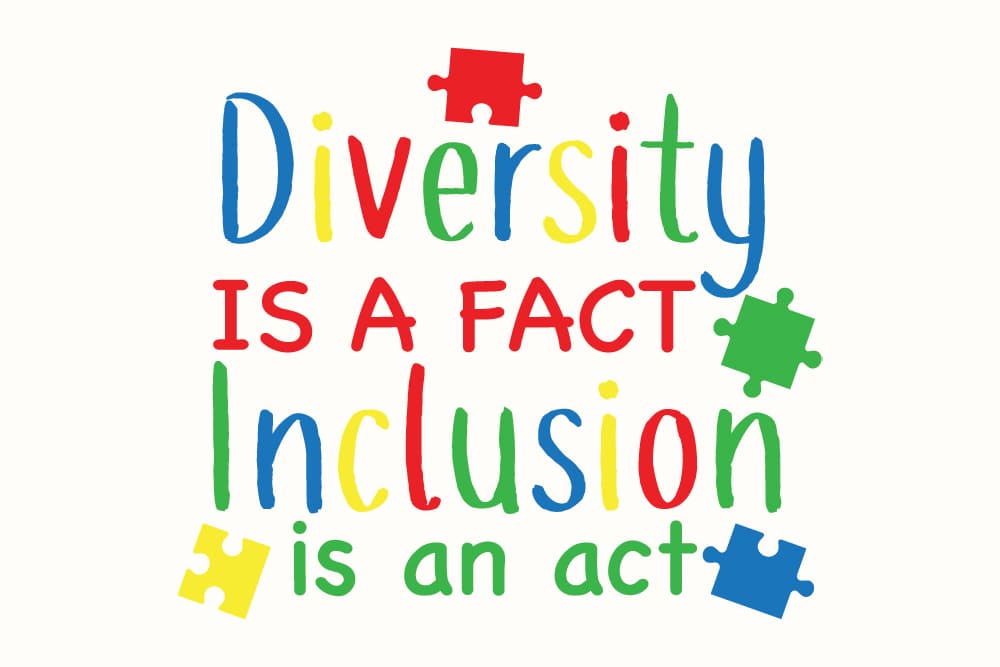
Everyone benefits from equality and diversity in the workplace, which you probably already suspected since you’re reading this guide.
There are apparent moral benefits – discrimination and disadvantage exist and can only be eliminated with consistent, organised efforts.
Improved decision-making, better talent retention and higher profit margins are clear business benefits, too.
Of course, these outcomes aren’t separate. Challenging discrimination and removing systemic disadvantages unlock the business value of equality and diversity.
Read our five fundamental strategies to boost equality and diversity in your organisation.
What are Equality and Diversity?
Equality, diversity and inclusion (EDI) strategies sometimes fail at the first hurdle. Without a shared understanding of EDI in the workplace, you won’t get everyone in your organisation invested.
Equality
Equality is probably the most misunderstood concept when developing an EDI strategy. It’s not about treating everyone exactly the same way. Giving everyone opportunities to have equally successful outcomes means some people will need to be treated differently.
An employee with a physical disability may require a specially designed workstation, for example. With the proper set-up, this employee could be just as productive and successful as their colleagues, which is the equality you should strive for.
Diversity
Equality depends on diversity. You can only determine what support or adjustments employees need if you acknowledge two things:
- Everyone is an individual
- People do face discrimination and disadvantage because of one (or more) of their characteristics
Diversity is all about recognising what makes us unique. These differences can make it harder for some people to succeed professionally. Disadvantages or discrimination are sometimes ingrained in policy – dress codes forbidding headscarves, for instance – or could be based on someone’s conscious or unconscious bias.

You should welcome employees from all backgrounds to benefit from the advantages of EDI in the workplace. So, ensure your recruitment policies are inclusive and promotions are merit-based.
Inclusivity
Although equality and diversity are the aim, inclusivity is how you will get there. Your EDI strategy will only succeed if you implement inclusive workplace practices and policies.
Examples of inclusivity include:
- Giving an employee an accessible workstation to accommodate a physical disability
- Expanding your definition of appropriate workplace attire to include cultural issues
Eliminating gender-specific language from job descriptions to encourage more applications

Anything you’ve done to increase diversity or promote equally positive outcomes for all your employees is an example of inclusivity.
The Business Benefits of EDI
Evidence shows that promoting EDI in the workplace can benefit your organisation in three key areas:
There’s also plenty of evidence that suggests diversity is directly linked to higher profits. While profitability might increase, recent research has suggested the relationship between EDI and gain isn’t entirely straightforward. It’s more likely that a business will progress in other areas, like those outlined above, yielding better returns.
The level of success you experience also depends on the effectiveness of your EDI strategy. You must ensure that underrepresented groups are supported and everyone in your organisation buys into your EDI initiatives.
How to Promote Equality and Diversity in the Workplace
There are a lot more than five strategies to promote EDI in the workplace. However, the methods outlined below are critical to any successful EDI strategy. The Chartered Institute of Personnel and Development (CIPD) is an excellent resource if you want to read more on EDI.
1 – Start at the Top
Any significant change in workplace culture starts at the top, so directors must commit to promoting the EDI strategy. The CIPD supports this, too. Its study found that EDI initiatives were most successful if supported by senior management. The same survey found that senior managers helped EDI policies provided they felt ownership over them.
2 – Measure Your Current Performance
Gather data so you know where you need to focus your EDI efforts. Key areas to start include your recruitment data and payroll. (It’s 2023; the gender pay gap shouldn’t be a thing anymore).
You should also pursue qualitative data as well as quantitative. Surveys reveal if your employees feel equality and diversity are valued and can suggest areas where you need to develop inclusivity.
3 – Review Policies
As with any initiative, you must regularly review your progress and adjust your strategy. Of course, you can only determine if your policies are working if you have a benchmark to measure against. You should have data from your original round of information gathering. Comparing your organisation’s EDI performance against competitors can also be helpful.
And, just like the second point, success isn’t just measured in figures. Talk with employees regularly and ask for their opinions on how things are going.
4 – Engage Middle Managers
The CIPD’s research found that line managers were a more common obstacle to improving EDI than senior leaders. While directors and executives were motivated by their authority on EDI policy, middle managers were unsupportive because of a perceived lack of influence. Line managers also failed to see any relevance EDI had with day-to-day operations.
To overcome this, you must ensure managers of all levels understand the aims and potential benefits of improving EDI in the workplace. Provide them with evidence that it will directly enhance the areas where line managers are responsible.
5 – Provide Staff Training
For EDI policies to succeed, all staff must commit. A collective awareness of aims, strategies and potential benefits is required. Employees must also believe the ambition to improve EDI is genuine, with management doing more than just talking about the issue.
Training can achieve both of these aims. It develops a shared understanding of EDI concepts and advantages. It’s also evidence that your organisation invests more than words into its EDI strategy.
Our online Equality and Diversity training course is an ideal first step for any organisation. It covers the basics of EDI, including definitions and examples of discrimination and how to overcome it. It encourages buy-in from your employees and promotes inclusive practice in the workplace.



















































































































































































































































































































































































































































































































































































































































































































































